Technological Advancements in Mitigating Bike Accidents in India
VerifiedAdded on 2022/11/13
|12
|3580
|439
Report
AI Summary
This research project investigates the contribution of technological advancements in mitigating motorcycle accidents in India. The report begins with an introduction highlighting the significant public health concern of motorcycle accidents, especially in India. It then defines the problem, emphasizing the rapid increase in two-wheeler vehicles and road congestion, which have led to a rise in accidents. The research questions explore how modern technologies can prevent accidents, improve safety, and are economically viable. The methodology employs a pragmatism research philosophy and an inductive research approach, using secondary data collection from various sources. The research design is exploratory, focusing on various technologies like curve speed warnings and road surface condition monitoring to prevent accidents. The expected tangible outputs include an analysis of these technologies' effectiveness and recommendations for their implementation. The reflective part emphasizes the project's inspiration from Intelligent Transportation Systems (ITS) and its potential real-world applications. The report aims to provide insights for motorcycle riders and stakeholders on how technology can improve road safety in India.
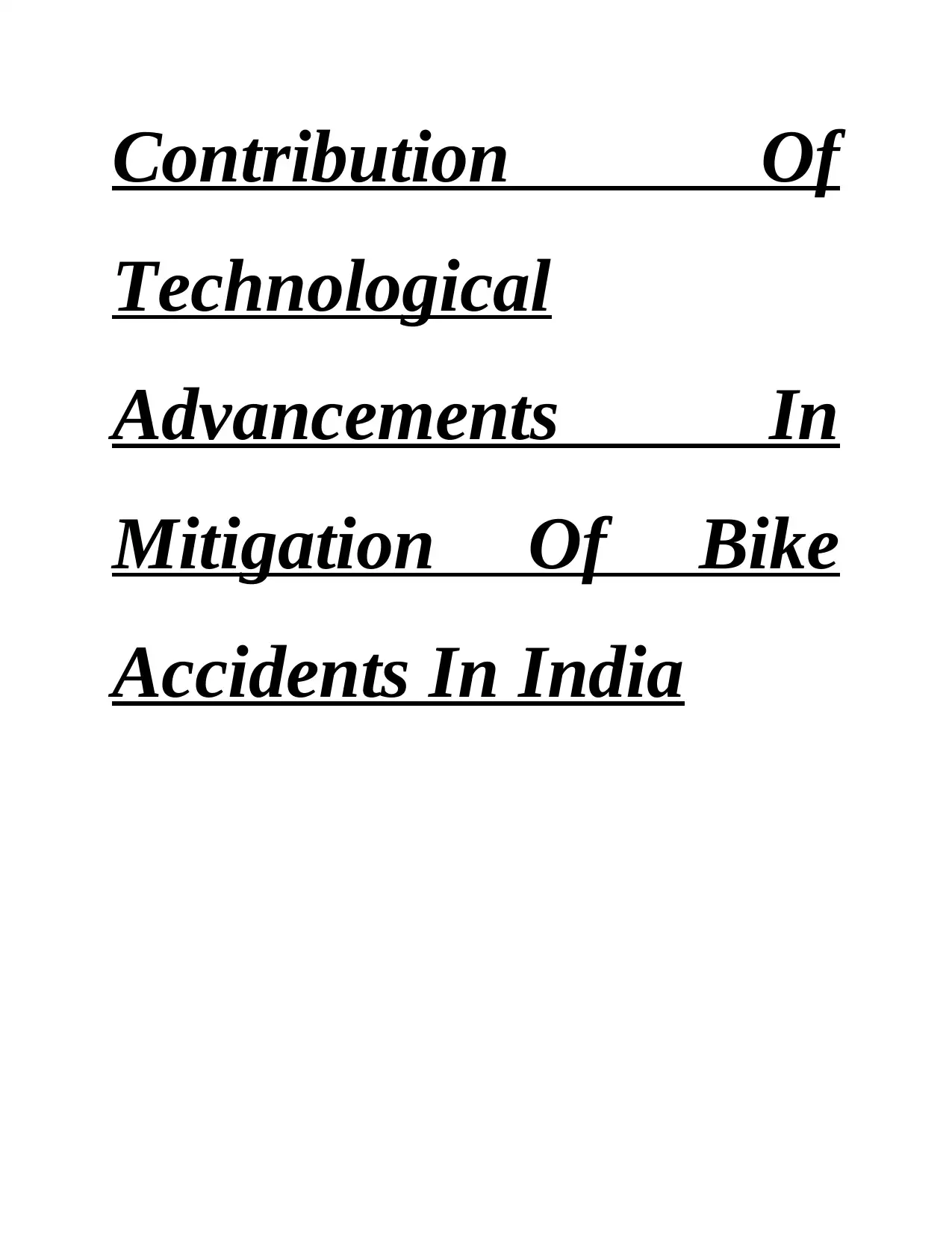
Contribution Of
Technological
Advancements In
Mitigation Of Bike
Accidents In India
Technological
Advancements In
Mitigation Of Bike
Accidents In India
Paraphrase This Document
Need a fresh take? Get an instant paraphrase of this document with our AI Paraphraser
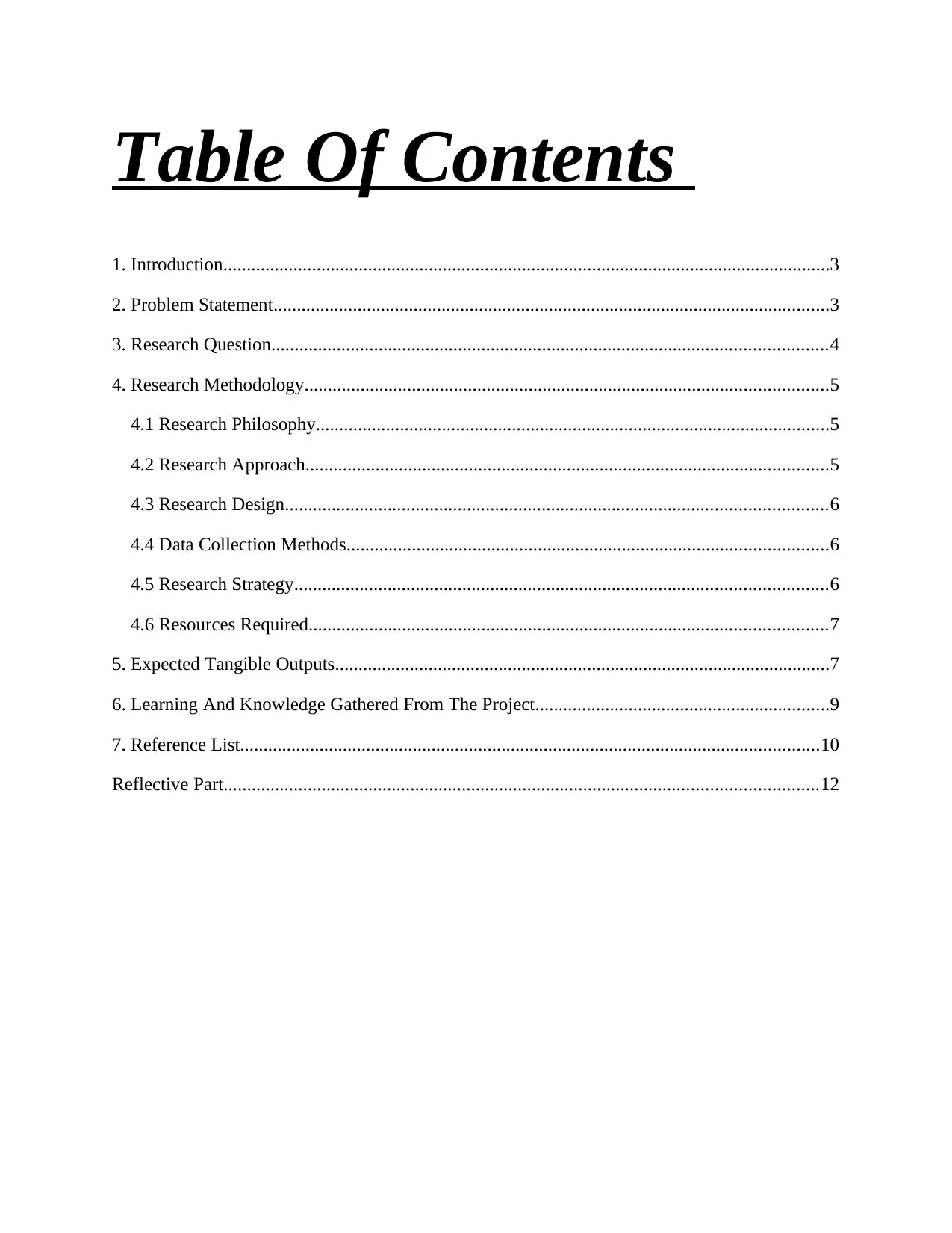
Table Of Contents
1. Introduction..................................................................................................................................3
2. Problem Statement.......................................................................................................................3
3. Research Question.......................................................................................................................4
4. Research Methodology................................................................................................................5
4.1 Research Philosophy..............................................................................................................5
4.2 Research Approach................................................................................................................5
4.3 Research Design....................................................................................................................6
4.4 Data Collection Methods.......................................................................................................6
4.5 Research Strategy..................................................................................................................6
4.6 Resources Required...............................................................................................................7
5. Expected Tangible Outputs..........................................................................................................7
6. Learning And Knowledge Gathered From The Project...............................................................9
7. Reference List............................................................................................................................10
Reflective Part...............................................................................................................................12
1. Introduction..................................................................................................................................3
2. Problem Statement.......................................................................................................................3
3. Research Question.......................................................................................................................4
4. Research Methodology................................................................................................................5
4.1 Research Philosophy..............................................................................................................5
4.2 Research Approach................................................................................................................5
4.3 Research Design....................................................................................................................6
4.4 Data Collection Methods.......................................................................................................6
4.5 Research Strategy..................................................................................................................6
4.6 Resources Required...............................................................................................................7
5. Expected Tangible Outputs..........................................................................................................7
6. Learning And Knowledge Gathered From The Project...............................................................9
7. Reference List............................................................................................................................10
Reflective Part...............................................................................................................................12
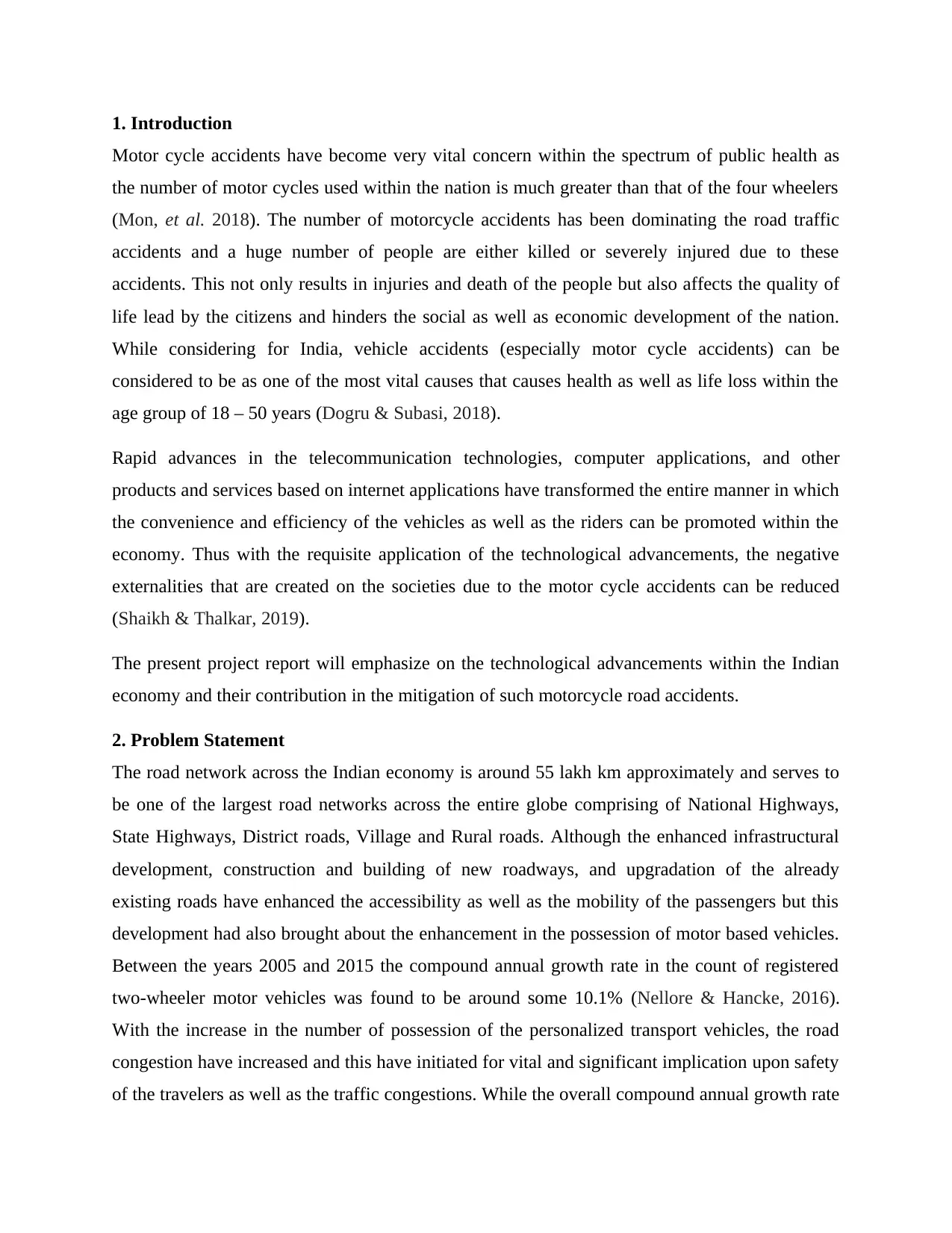
1. Introduction
Motor cycle accidents have become very vital concern within the spectrum of public health as
the number of motor cycles used within the nation is much greater than that of the four wheelers
(Mon, et al. 2018). The number of motorcycle accidents has been dominating the road traffic
accidents and a huge number of people are either killed or severely injured due to these
accidents. This not only results in injuries and death of the people but also affects the quality of
life lead by the citizens and hinders the social as well as economic development of the nation.
While considering for India, vehicle accidents (especially motor cycle accidents) can be
considered to be as one of the most vital causes that causes health as well as life loss within the
age group of 18 – 50 years (Dogru & Subasi, 2018).
Rapid advances in the telecommunication technologies, computer applications, and other
products and services based on internet applications have transformed the entire manner in which
the convenience and efficiency of the vehicles as well as the riders can be promoted within the
economy. Thus with the requisite application of the technological advancements, the negative
externalities that are created on the societies due to the motor cycle accidents can be reduced
(Shaikh & Thalkar, 2019).
The present project report will emphasize on the technological advancements within the Indian
economy and their contribution in the mitigation of such motorcycle road accidents.
2. Problem Statement
The road network across the Indian economy is around 55 lakh km approximately and serves to
be one of the largest road networks across the entire globe comprising of National Highways,
State Highways, District roads, Village and Rural roads. Although the enhanced infrastructural
development, construction and building of new roadways, and upgradation of the already
existing roads have enhanced the accessibility as well as the mobility of the passengers but this
development had also brought about the enhancement in the possession of motor based vehicles.
Between the years 2005 and 2015 the compound annual growth rate in the count of registered
two-wheeler motor vehicles was found to be around some 10.1% (Nellore & Hancke, 2016).
With the increase in the number of possession of the personalized transport vehicles, the road
congestion have increased and this have initiated for vital and significant implication upon safety
of the travelers as well as the traffic congestions. While the overall compound annual growth rate
Motor cycle accidents have become very vital concern within the spectrum of public health as
the number of motor cycles used within the nation is much greater than that of the four wheelers
(Mon, et al. 2018). The number of motorcycle accidents has been dominating the road traffic
accidents and a huge number of people are either killed or severely injured due to these
accidents. This not only results in injuries and death of the people but also affects the quality of
life lead by the citizens and hinders the social as well as economic development of the nation.
While considering for India, vehicle accidents (especially motor cycle accidents) can be
considered to be as one of the most vital causes that causes health as well as life loss within the
age group of 18 – 50 years (Dogru & Subasi, 2018).
Rapid advances in the telecommunication technologies, computer applications, and other
products and services based on internet applications have transformed the entire manner in which
the convenience and efficiency of the vehicles as well as the riders can be promoted within the
economy. Thus with the requisite application of the technological advancements, the negative
externalities that are created on the societies due to the motor cycle accidents can be reduced
(Shaikh & Thalkar, 2019).
The present project report will emphasize on the technological advancements within the Indian
economy and their contribution in the mitigation of such motorcycle road accidents.
2. Problem Statement
The road network across the Indian economy is around 55 lakh km approximately and serves to
be one of the largest road networks across the entire globe comprising of National Highways,
State Highways, District roads, Village and Rural roads. Although the enhanced infrastructural
development, construction and building of new roadways, and upgradation of the already
existing roads have enhanced the accessibility as well as the mobility of the passengers but this
development had also brought about the enhancement in the possession of motor based vehicles.
Between the years 2005 and 2015 the compound annual growth rate in the count of registered
two-wheeler motor vehicles was found to be around some 10.1% (Nellore & Hancke, 2016).
With the increase in the number of possession of the personalized transport vehicles, the road
congestion have increased and this have initiated for vital and significant implication upon safety
of the travelers as well as the traffic congestions. While the overall compound annual growth rate
⊘ This is a preview!⊘
Do you want full access?
Subscribe today to unlock all pages.

Trusted by 1+ million students worldwide
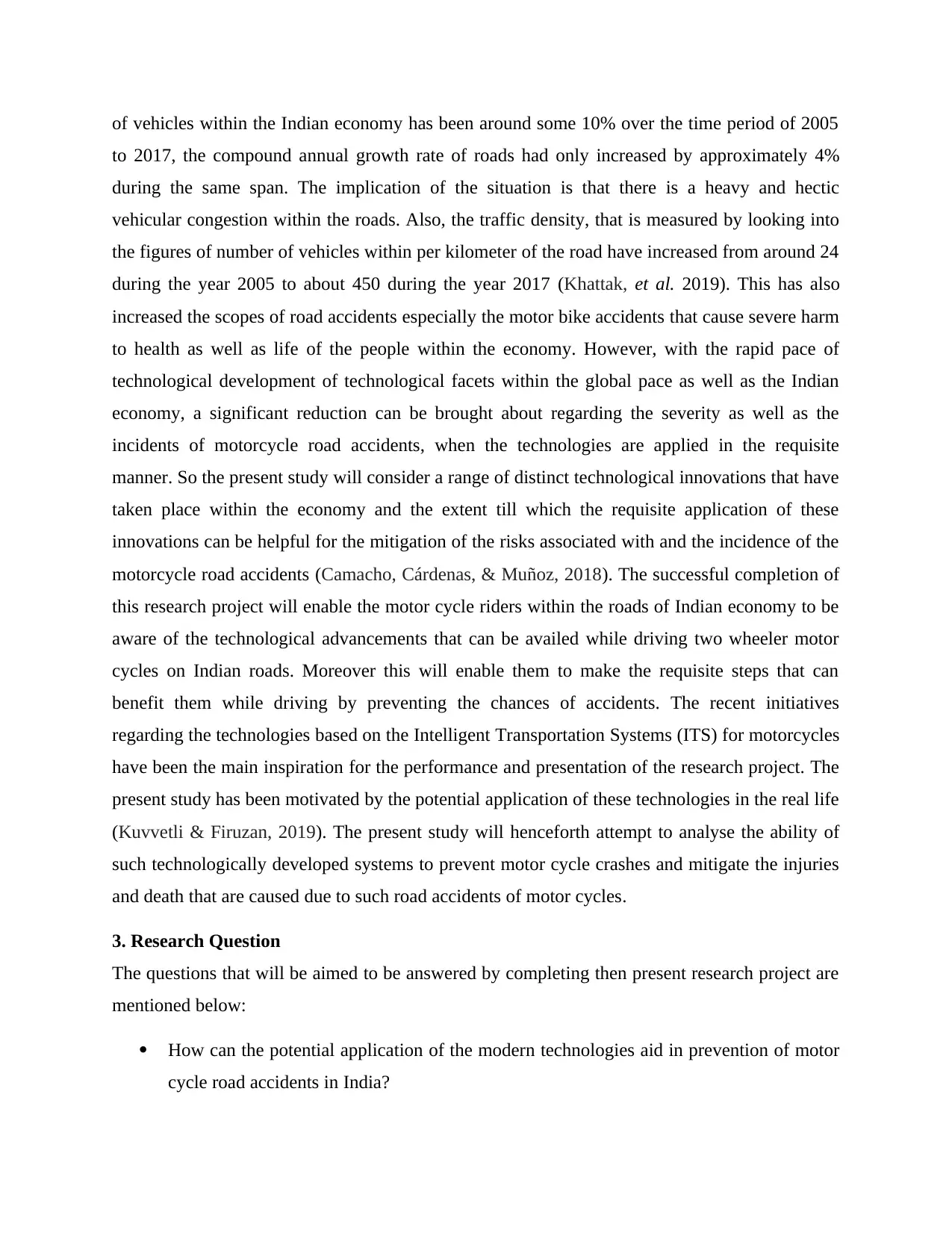
of vehicles within the Indian economy has been around some 10% over the time period of 2005
to 2017, the compound annual growth rate of roads had only increased by approximately 4%
during the same span. The implication of the situation is that there is a heavy and hectic
vehicular congestion within the roads. Also, the traffic density, that is measured by looking into
the figures of number of vehicles within per kilometer of the road have increased from around 24
during the year 2005 to about 450 during the year 2017 (Khattak, et al. 2019). This has also
increased the scopes of road accidents especially the motor bike accidents that cause severe harm
to health as well as life of the people within the economy. However, with the rapid pace of
technological development of technological facets within the global pace as well as the Indian
economy, a significant reduction can be brought about regarding the severity as well as the
incidents of motorcycle road accidents, when the technologies are applied in the requisite
manner. So the present study will consider a range of distinct technological innovations that have
taken place within the economy and the extent till which the requisite application of these
innovations can be helpful for the mitigation of the risks associated with and the incidence of the
motorcycle road accidents (Camacho, Cárdenas, & Muñoz, 2018). The successful completion of
this research project will enable the motor cycle riders within the roads of Indian economy to be
aware of the technological advancements that can be availed while driving two wheeler motor
cycles on Indian roads. Moreover this will enable them to make the requisite steps that can
benefit them while driving by preventing the chances of accidents. The recent initiatives
regarding the technologies based on the Intelligent Transportation Systems (ITS) for motorcycles
have been the main inspiration for the performance and presentation of the research project. The
present study has been motivated by the potential application of these technologies in the real life
(Kuvvetli & Firuzan, 2019). The present study will henceforth attempt to analyse the ability of
such technologically developed systems to prevent motor cycle crashes and mitigate the injuries
and death that are caused due to such road accidents of motor cycles.
3. Research Question
The questions that will be aimed to be answered by completing then present research project are
mentioned below:
How can the potential application of the modern technologies aid in prevention of motor
cycle road accidents in India?
to 2017, the compound annual growth rate of roads had only increased by approximately 4%
during the same span. The implication of the situation is that there is a heavy and hectic
vehicular congestion within the roads. Also, the traffic density, that is measured by looking into
the figures of number of vehicles within per kilometer of the road have increased from around 24
during the year 2005 to about 450 during the year 2017 (Khattak, et al. 2019). This has also
increased the scopes of road accidents especially the motor bike accidents that cause severe harm
to health as well as life of the people within the economy. However, with the rapid pace of
technological development of technological facets within the global pace as well as the Indian
economy, a significant reduction can be brought about regarding the severity as well as the
incidents of motorcycle road accidents, when the technologies are applied in the requisite
manner. So the present study will consider a range of distinct technological innovations that have
taken place within the economy and the extent till which the requisite application of these
innovations can be helpful for the mitigation of the risks associated with and the incidence of the
motorcycle road accidents (Camacho, Cárdenas, & Muñoz, 2018). The successful completion of
this research project will enable the motor cycle riders within the roads of Indian economy to be
aware of the technological advancements that can be availed while driving two wheeler motor
cycles on Indian roads. Moreover this will enable them to make the requisite steps that can
benefit them while driving by preventing the chances of accidents. The recent initiatives
regarding the technologies based on the Intelligent Transportation Systems (ITS) for motorcycles
have been the main inspiration for the performance and presentation of the research project. The
present study has been motivated by the potential application of these technologies in the real life
(Kuvvetli & Firuzan, 2019). The present study will henceforth attempt to analyse the ability of
such technologically developed systems to prevent motor cycle crashes and mitigate the injuries
and death that are caused due to such road accidents of motor cycles.
3. Research Question
The questions that will be aimed to be answered by completing then present research project are
mentioned below:
How can the potential application of the modern technologies aid in prevention of motor
cycle road accidents in India?
Paraphrase This Document
Need a fresh take? Get an instant paraphrase of this document with our AI Paraphraser
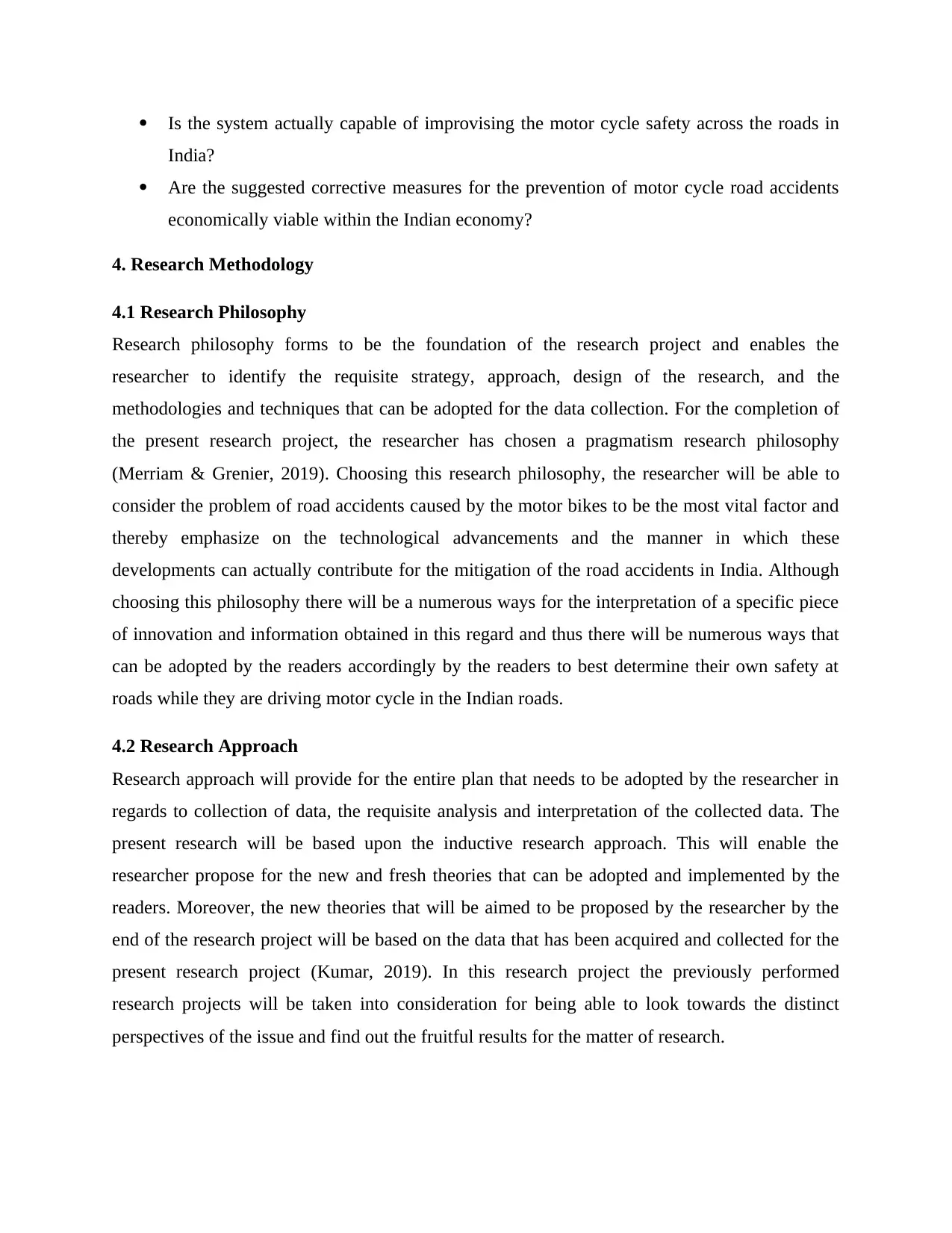
Is the system actually capable of improvising the motor cycle safety across the roads in
India?
Are the suggested corrective measures for the prevention of motor cycle road accidents
economically viable within the Indian economy?
4. Research Methodology
4.1 Research Philosophy
Research philosophy forms to be the foundation of the research project and enables the
researcher to identify the requisite strategy, approach, design of the research, and the
methodologies and techniques that can be adopted for the data collection. For the completion of
the present research project, the researcher has chosen a pragmatism research philosophy
(Merriam & Grenier, 2019). Choosing this research philosophy, the researcher will be able to
consider the problem of road accidents caused by the motor bikes to be the most vital factor and
thereby emphasize on the technological advancements and the manner in which these
developments can actually contribute for the mitigation of the road accidents in India. Although
choosing this philosophy there will be a numerous ways for the interpretation of a specific piece
of innovation and information obtained in this regard and thus there will be numerous ways that
can be adopted by the readers accordingly by the readers to best determine their own safety at
roads while they are driving motor cycle in the Indian roads.
4.2 Research Approach
Research approach will provide for the entire plan that needs to be adopted by the researcher in
regards to collection of data, the requisite analysis and interpretation of the collected data. The
present research will be based upon the inductive research approach. This will enable the
researcher propose for the new and fresh theories that can be adopted and implemented by the
readers. Moreover, the new theories that will be aimed to be proposed by the researcher by the
end of the research project will be based on the data that has been acquired and collected for the
present research project (Kumar, 2019). In this research project the previously performed
research projects will be taken into consideration for being able to look towards the distinct
perspectives of the issue and find out the fruitful results for the matter of research.
India?
Are the suggested corrective measures for the prevention of motor cycle road accidents
economically viable within the Indian economy?
4. Research Methodology
4.1 Research Philosophy
Research philosophy forms to be the foundation of the research project and enables the
researcher to identify the requisite strategy, approach, design of the research, and the
methodologies and techniques that can be adopted for the data collection. For the completion of
the present research project, the researcher has chosen a pragmatism research philosophy
(Merriam & Grenier, 2019). Choosing this research philosophy, the researcher will be able to
consider the problem of road accidents caused by the motor bikes to be the most vital factor and
thereby emphasize on the technological advancements and the manner in which these
developments can actually contribute for the mitigation of the road accidents in India. Although
choosing this philosophy there will be a numerous ways for the interpretation of a specific piece
of innovation and information obtained in this regard and thus there will be numerous ways that
can be adopted by the readers accordingly by the readers to best determine their own safety at
roads while they are driving motor cycle in the Indian roads.
4.2 Research Approach
Research approach will provide for the entire plan that needs to be adopted by the researcher in
regards to collection of data, the requisite analysis and interpretation of the collected data. The
present research will be based upon the inductive research approach. This will enable the
researcher propose for the new and fresh theories that can be adopted and implemented by the
readers. Moreover, the new theories that will be aimed to be proposed by the researcher by the
end of the research project will be based on the data that has been acquired and collected for the
present research project (Kumar, 2019). In this research project the previously performed
research projects will be taken into consideration for being able to look towards the distinct
perspectives of the issue and find out the fruitful results for the matter of research.
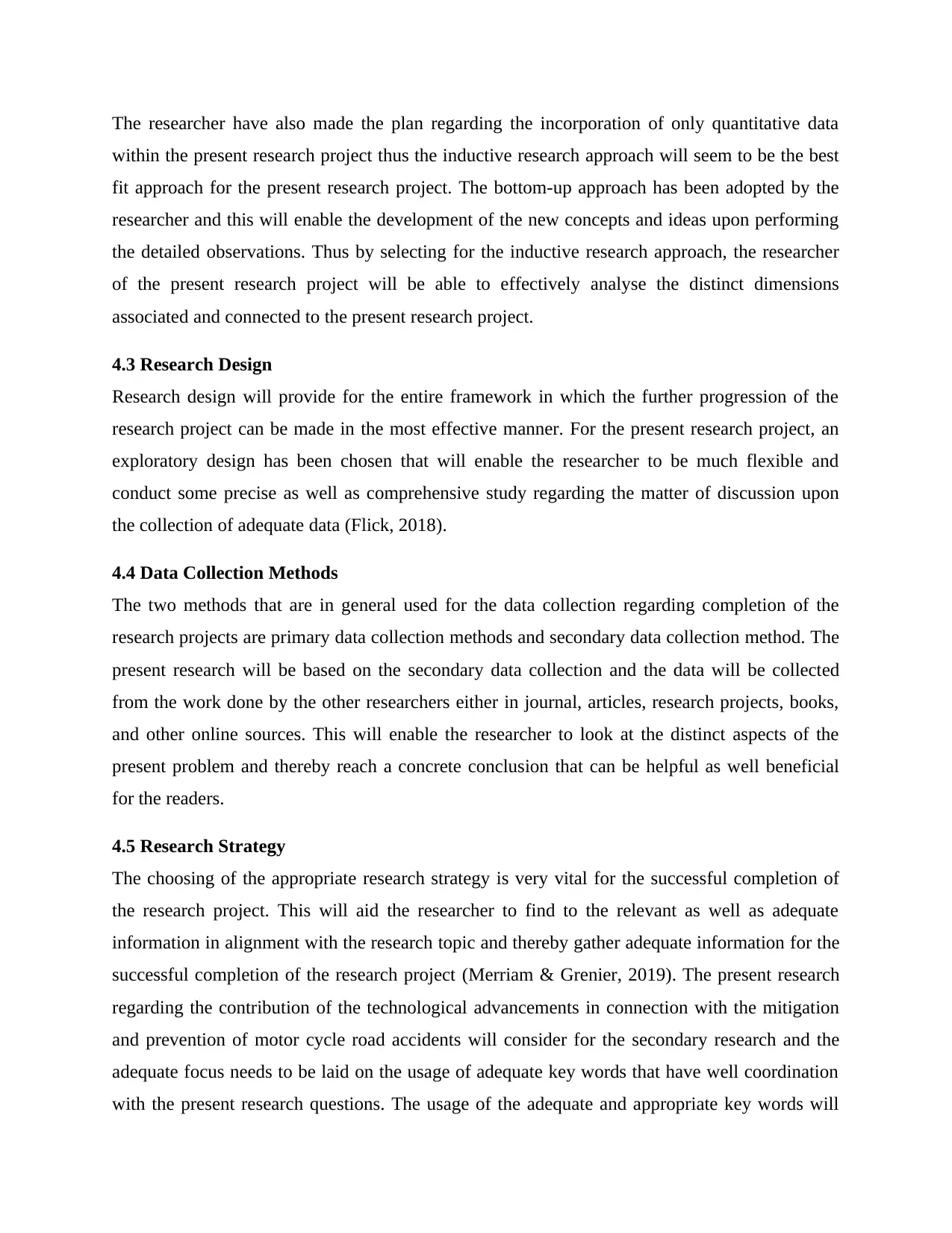
The researcher have also made the plan regarding the incorporation of only quantitative data
within the present research project thus the inductive research approach will seem to be the best
fit approach for the present research project. The bottom-up approach has been adopted by the
researcher and this will enable the development of the new concepts and ideas upon performing
the detailed observations. Thus by selecting for the inductive research approach, the researcher
of the present research project will be able to effectively analyse the distinct dimensions
associated and connected to the present research project.
4.3 Research Design
Research design will provide for the entire framework in which the further progression of the
research project can be made in the most effective manner. For the present research project, an
exploratory design has been chosen that will enable the researcher to be much flexible and
conduct some precise as well as comprehensive study regarding the matter of discussion upon
the collection of adequate data (Flick, 2018).
4.4 Data Collection Methods
The two methods that are in general used for the data collection regarding completion of the
research projects are primary data collection methods and secondary data collection method. The
present research will be based on the secondary data collection and the data will be collected
from the work done by the other researchers either in journal, articles, research projects, books,
and other online sources. This will enable the researcher to look at the distinct aspects of the
present problem and thereby reach a concrete conclusion that can be helpful as well beneficial
for the readers.
4.5 Research Strategy
The choosing of the appropriate research strategy is very vital for the successful completion of
the research project. This will aid the researcher to find to the relevant as well as adequate
information in alignment with the research topic and thereby gather adequate information for the
successful completion of the research project (Merriam & Grenier, 2019). The present research
regarding the contribution of the technological advancements in connection with the mitigation
and prevention of motor cycle road accidents will consider for the secondary research and the
adequate focus needs to be laid on the usage of adequate key words that have well coordination
with the present research questions. The usage of the adequate and appropriate key words will
within the present research project thus the inductive research approach will seem to be the best
fit approach for the present research project. The bottom-up approach has been adopted by the
researcher and this will enable the development of the new concepts and ideas upon performing
the detailed observations. Thus by selecting for the inductive research approach, the researcher
of the present research project will be able to effectively analyse the distinct dimensions
associated and connected to the present research project.
4.3 Research Design
Research design will provide for the entire framework in which the further progression of the
research project can be made in the most effective manner. For the present research project, an
exploratory design has been chosen that will enable the researcher to be much flexible and
conduct some precise as well as comprehensive study regarding the matter of discussion upon
the collection of adequate data (Flick, 2018).
4.4 Data Collection Methods
The two methods that are in general used for the data collection regarding completion of the
research projects are primary data collection methods and secondary data collection method. The
present research will be based on the secondary data collection and the data will be collected
from the work done by the other researchers either in journal, articles, research projects, books,
and other online sources. This will enable the researcher to look at the distinct aspects of the
present problem and thereby reach a concrete conclusion that can be helpful as well beneficial
for the readers.
4.5 Research Strategy
The choosing of the appropriate research strategy is very vital for the successful completion of
the research project. This will aid the researcher to find to the relevant as well as adequate
information in alignment with the research topic and thereby gather adequate information for the
successful completion of the research project (Merriam & Grenier, 2019). The present research
regarding the contribution of the technological advancements in connection with the mitigation
and prevention of motor cycle road accidents will consider for the secondary research and the
adequate focus needs to be laid on the usage of adequate key words that have well coordination
with the present research questions. The usage of the adequate and appropriate key words will
⊘ This is a preview!⊘
Do you want full access?
Subscribe today to unlock all pages.

Trusted by 1+ million students worldwide
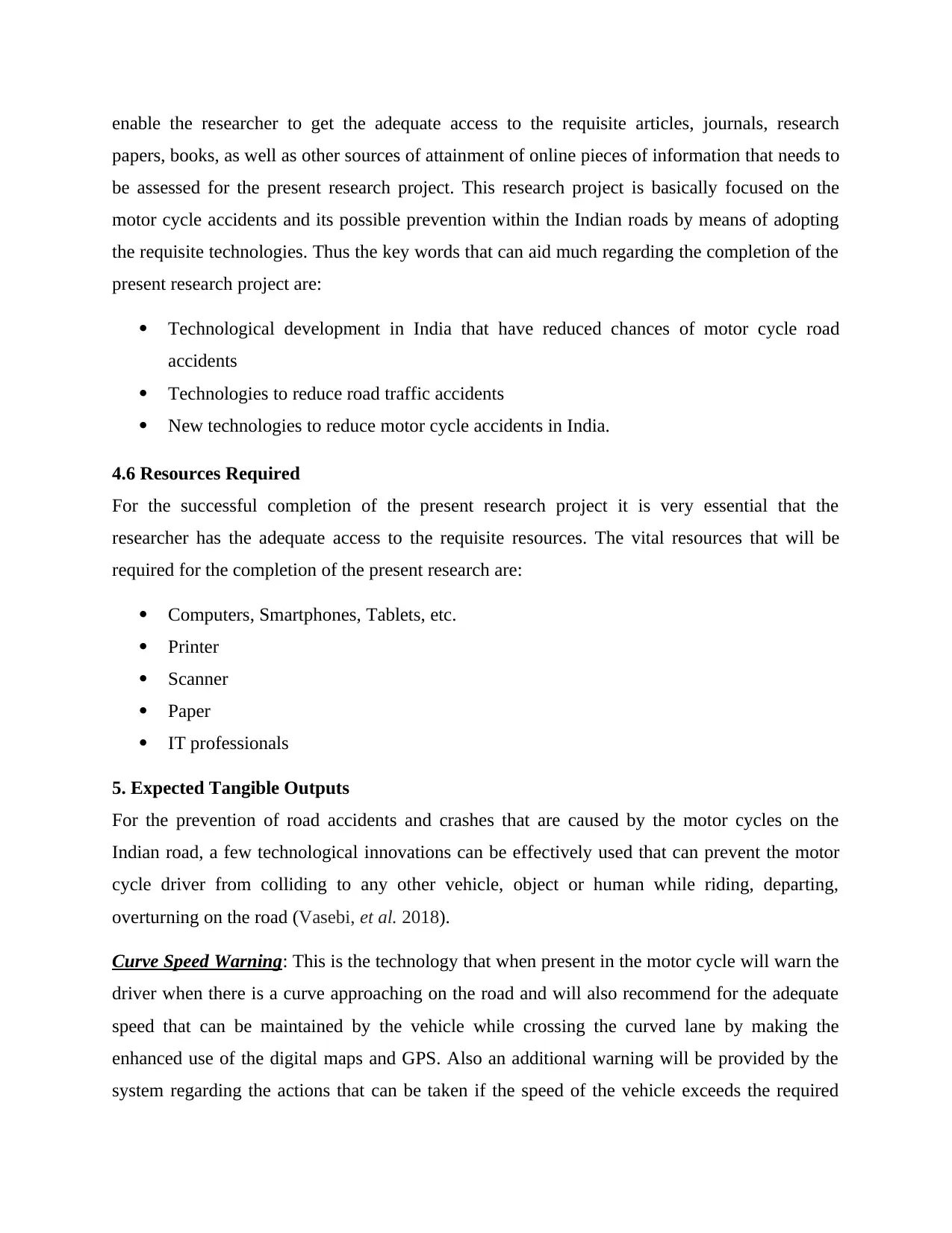
enable the researcher to get the adequate access to the requisite articles, journals, research
papers, books, as well as other sources of attainment of online pieces of information that needs to
be assessed for the present research project. This research project is basically focused on the
motor cycle accidents and its possible prevention within the Indian roads by means of adopting
the requisite technologies. Thus the key words that can aid much regarding the completion of the
present research project are:
Technological development in India that have reduced chances of motor cycle road
accidents
Technologies to reduce road traffic accidents
New technologies to reduce motor cycle accidents in India.
4.6 Resources Required
For the successful completion of the present research project it is very essential that the
researcher has the adequate access to the requisite resources. The vital resources that will be
required for the completion of the present research are:
Computers, Smartphones, Tablets, etc.
Printer
Scanner
Paper
IT professionals
5. Expected Tangible Outputs
For the prevention of road accidents and crashes that are caused by the motor cycles on the
Indian road, a few technological innovations can be effectively used that can prevent the motor
cycle driver from colliding to any other vehicle, object or human while riding, departing,
overturning on the road (Vasebi, et al. 2018).
Curve Speed Warning: This is the technology that when present in the motor cycle will warn the
driver when there is a curve approaching on the road and will also recommend for the adequate
speed that can be maintained by the vehicle while crossing the curved lane by making the
enhanced use of the digital maps and GPS. Also an additional warning will be provided by the
system regarding the actions that can be taken if the speed of the vehicle exceeds the required
papers, books, as well as other sources of attainment of online pieces of information that needs to
be assessed for the present research project. This research project is basically focused on the
motor cycle accidents and its possible prevention within the Indian roads by means of adopting
the requisite technologies. Thus the key words that can aid much regarding the completion of the
present research project are:
Technological development in India that have reduced chances of motor cycle road
accidents
Technologies to reduce road traffic accidents
New technologies to reduce motor cycle accidents in India.
4.6 Resources Required
For the successful completion of the present research project it is very essential that the
researcher has the adequate access to the requisite resources. The vital resources that will be
required for the completion of the present research are:
Computers, Smartphones, Tablets, etc.
Printer
Scanner
Paper
IT professionals
5. Expected Tangible Outputs
For the prevention of road accidents and crashes that are caused by the motor cycles on the
Indian road, a few technological innovations can be effectively used that can prevent the motor
cycle driver from colliding to any other vehicle, object or human while riding, departing,
overturning on the road (Vasebi, et al. 2018).
Curve Speed Warning: This is the technology that when present in the motor cycle will warn the
driver when there is a curve approaching on the road and will also recommend for the adequate
speed that can be maintained by the vehicle while crossing the curved lane by making the
enhanced use of the digital maps and GPS. Also an additional warning will be provided by the
system regarding the actions that can be taken if the speed of the vehicle exceeds the required
Paraphrase This Document
Need a fresh take? Get an instant paraphrase of this document with our AI Paraphraser
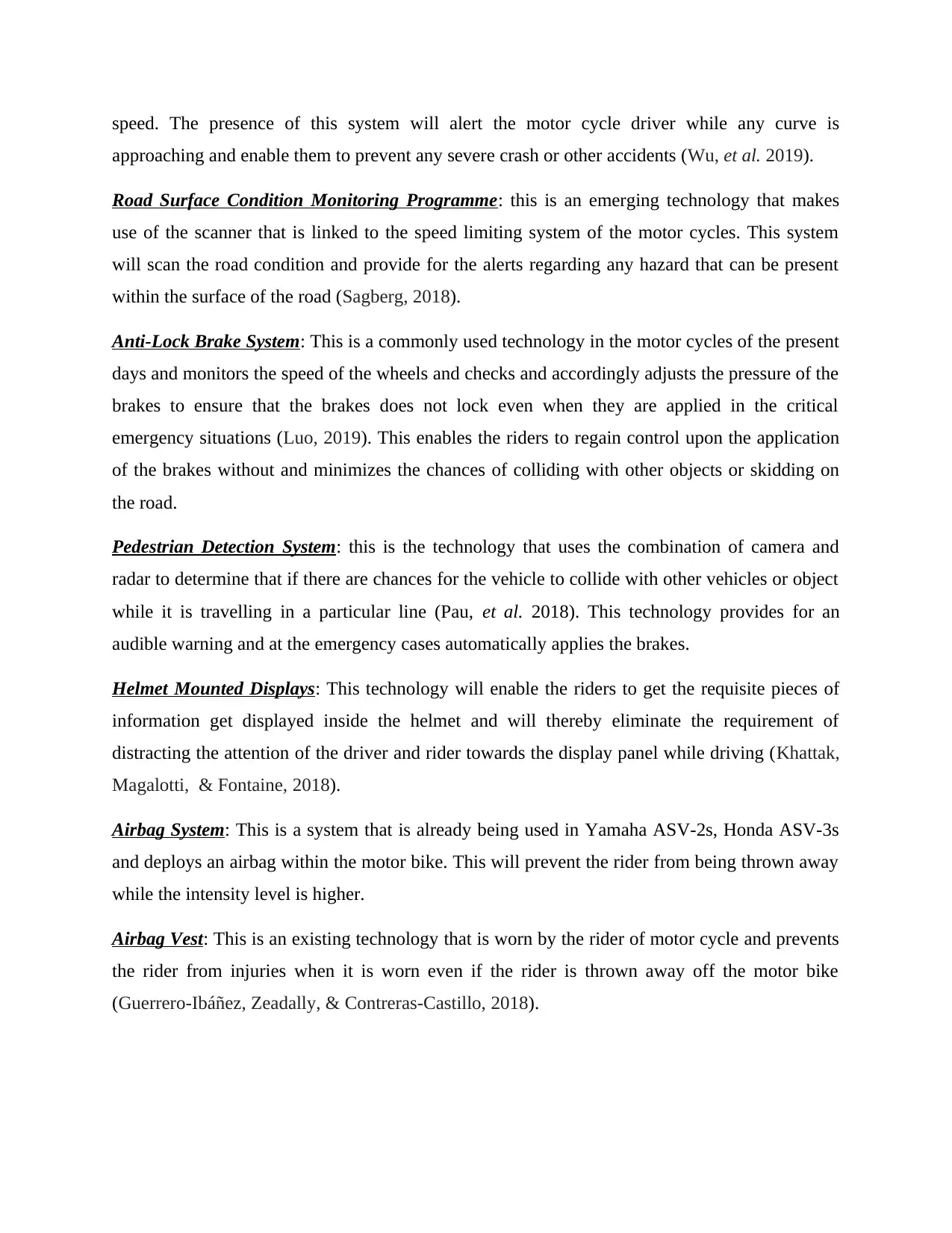
speed. The presence of this system will alert the motor cycle driver while any curve is
approaching and enable them to prevent any severe crash or other accidents (Wu, et al. 2019).
Road Surface Condition Monitoring Programme: this is an emerging technology that makes
use of the scanner that is linked to the speed limiting system of the motor cycles. This system
will scan the road condition and provide for the alerts regarding any hazard that can be present
within the surface of the road (Sagberg, 2018).
Anti-Lock Brake System: This is a commonly used technology in the motor cycles of the present
days and monitors the speed of the wheels and checks and accordingly adjusts the pressure of the
brakes to ensure that the brakes does not lock even when they are applied in the critical
emergency situations (Luo, 2019). This enables the riders to regain control upon the application
of the brakes without and minimizes the chances of colliding with other objects or skidding on
the road.
Pedestrian Detection System: this is the technology that uses the combination of camera and
radar to determine that if there are chances for the vehicle to collide with other vehicles or object
while it is travelling in a particular line (Pau, et al. 2018). This technology provides for an
audible warning and at the emergency cases automatically applies the brakes.
Helmet Mounted Displays: This technology will enable the riders to get the requisite pieces of
information get displayed inside the helmet and will thereby eliminate the requirement of
distracting the attention of the driver and rider towards the display panel while driving (Khattak,
Magalotti, & Fontaine, 2018).
Airbag System: This is a system that is already being used in Yamaha ASV-2s, Honda ASV-3s
and deploys an airbag within the motor bike. This will prevent the rider from being thrown away
while the intensity level is higher.
Airbag Vest: This is an existing technology that is worn by the rider of motor cycle and prevents
the rider from injuries when it is worn even if the rider is thrown away off the motor bike
(Guerrero-Ibáñez, Zeadally, & Contreras-Castillo, 2018).
approaching and enable them to prevent any severe crash or other accidents (Wu, et al. 2019).
Road Surface Condition Monitoring Programme: this is an emerging technology that makes
use of the scanner that is linked to the speed limiting system of the motor cycles. This system
will scan the road condition and provide for the alerts regarding any hazard that can be present
within the surface of the road (Sagberg, 2018).
Anti-Lock Brake System: This is a commonly used technology in the motor cycles of the present
days and monitors the speed of the wheels and checks and accordingly adjusts the pressure of the
brakes to ensure that the brakes does not lock even when they are applied in the critical
emergency situations (Luo, 2019). This enables the riders to regain control upon the application
of the brakes without and minimizes the chances of colliding with other objects or skidding on
the road.
Pedestrian Detection System: this is the technology that uses the combination of camera and
radar to determine that if there are chances for the vehicle to collide with other vehicles or object
while it is travelling in a particular line (Pau, et al. 2018). This technology provides for an
audible warning and at the emergency cases automatically applies the brakes.
Helmet Mounted Displays: This technology will enable the riders to get the requisite pieces of
information get displayed inside the helmet and will thereby eliminate the requirement of
distracting the attention of the driver and rider towards the display panel while driving (Khattak,
Magalotti, & Fontaine, 2018).
Airbag System: This is a system that is already being used in Yamaha ASV-2s, Honda ASV-3s
and deploys an airbag within the motor bike. This will prevent the rider from being thrown away
while the intensity level is higher.
Airbag Vest: This is an existing technology that is worn by the rider of motor cycle and prevents
the rider from injuries when it is worn even if the rider is thrown away off the motor bike
(Guerrero-Ibáñez, Zeadally, & Contreras-Castillo, 2018).
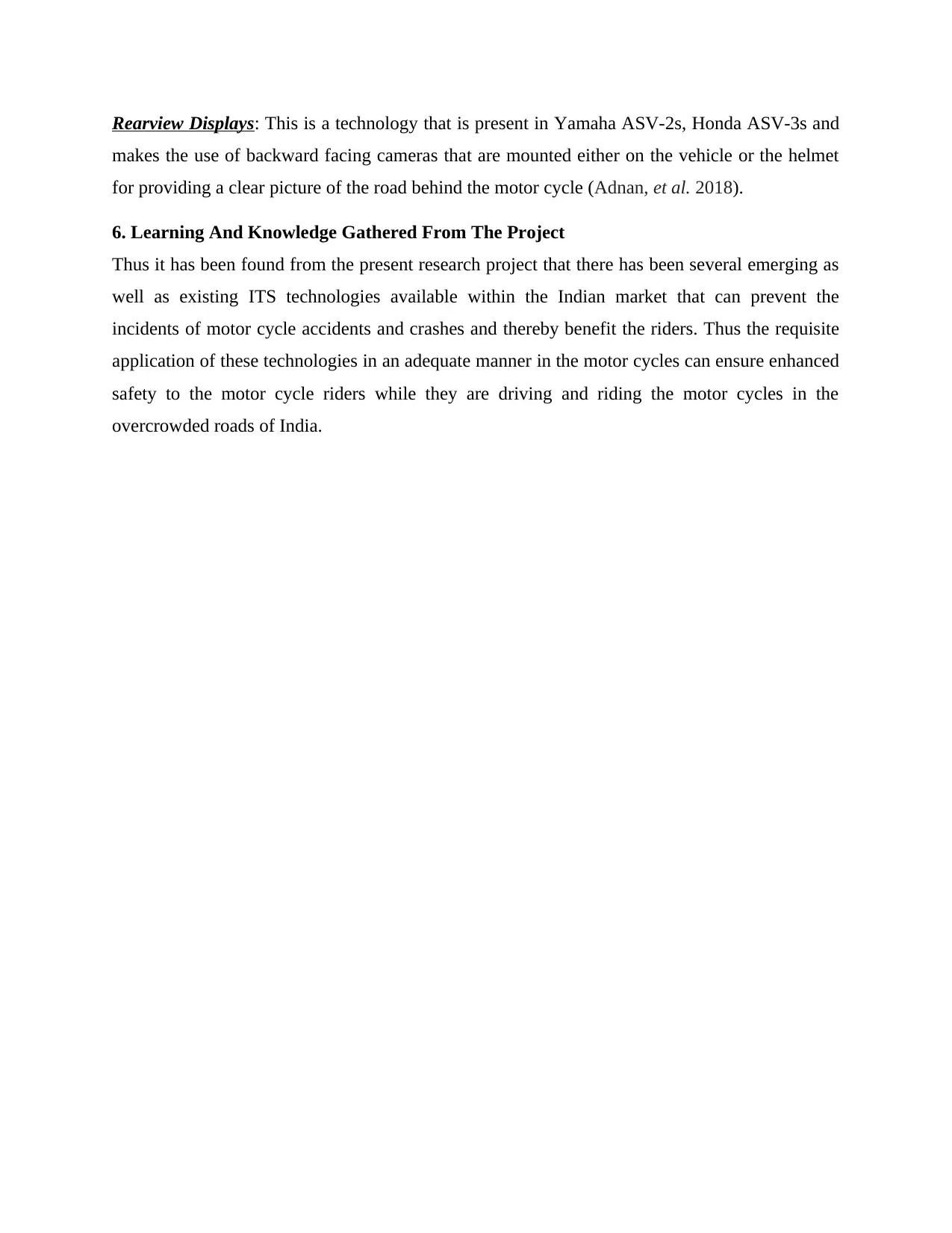
Rearview Displays: This is a technology that is present in Yamaha ASV-2s, Honda ASV-3s and
makes the use of backward facing cameras that are mounted either on the vehicle or the helmet
for providing a clear picture of the road behind the motor cycle (Adnan, et al. 2018).
6. Learning And Knowledge Gathered From The Project
Thus it has been found from the present research project that there has been several emerging as
well as existing ITS technologies available within the Indian market that can prevent the
incidents of motor cycle accidents and crashes and thereby benefit the riders. Thus the requisite
application of these technologies in an adequate manner in the motor cycles can ensure enhanced
safety to the motor cycle riders while they are driving and riding the motor cycles in the
overcrowded roads of India.
makes the use of backward facing cameras that are mounted either on the vehicle or the helmet
for providing a clear picture of the road behind the motor cycle (Adnan, et al. 2018).
6. Learning And Knowledge Gathered From The Project
Thus it has been found from the present research project that there has been several emerging as
well as existing ITS technologies available within the Indian market that can prevent the
incidents of motor cycle accidents and crashes and thereby benefit the riders. Thus the requisite
application of these technologies in an adequate manner in the motor cycles can ensure enhanced
safety to the motor cycle riders while they are driving and riding the motor cycles in the
overcrowded roads of India.
⊘ This is a preview!⊘
Do you want full access?
Subscribe today to unlock all pages.

Trusted by 1+ million students worldwide
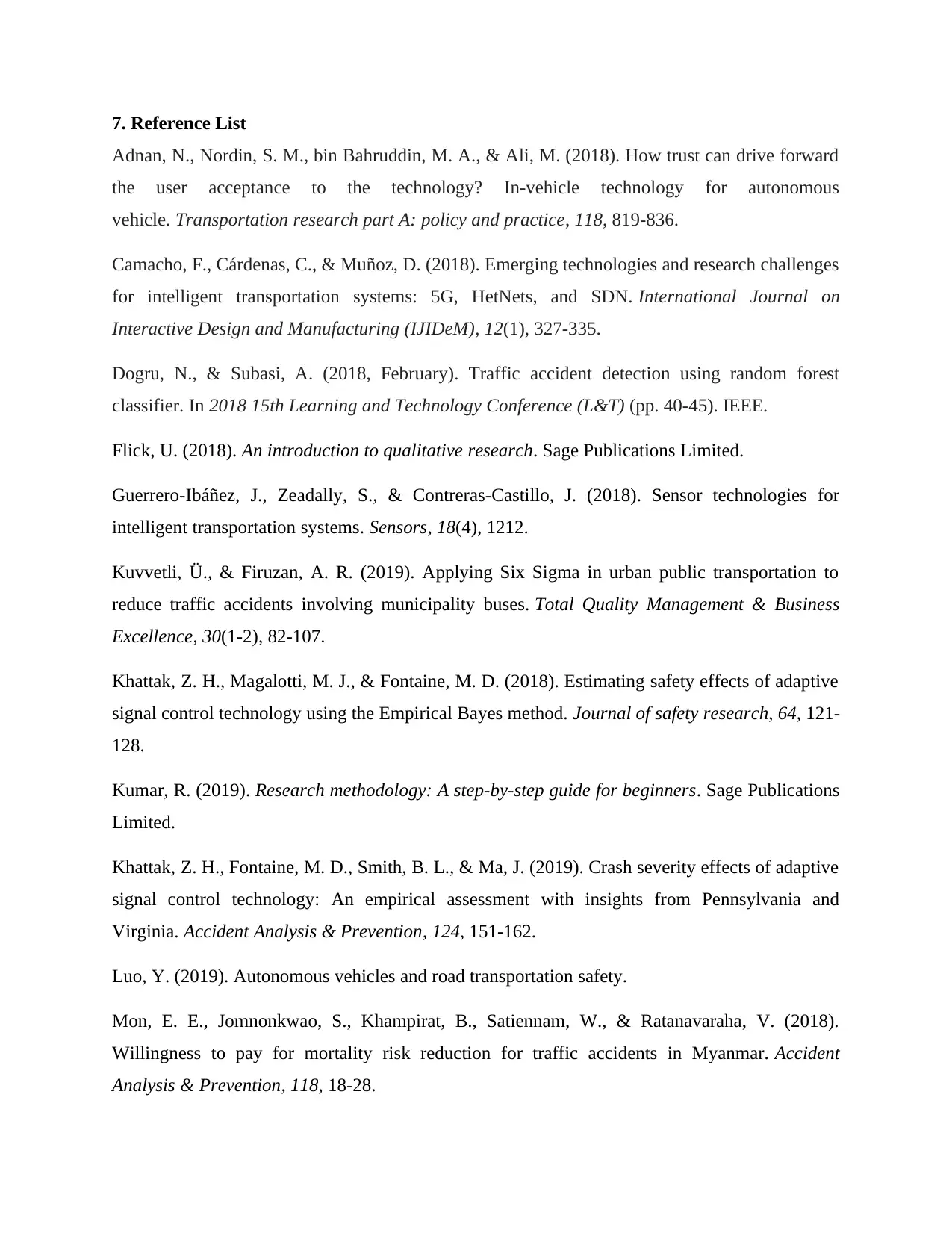
7. Reference List
Adnan, N., Nordin, S. M., bin Bahruddin, M. A., & Ali, M. (2018). How trust can drive forward
the user acceptance to the technology? In-vehicle technology for autonomous
vehicle. Transportation research part A: policy and practice, 118, 819-836.
Camacho, F., Cárdenas, C., & Muñoz, D. (2018). Emerging technologies and research challenges
for intelligent transportation systems: 5G, HetNets, and SDN. International Journal on
Interactive Design and Manufacturing (IJIDeM), 12(1), 327-335.
Dogru, N., & Subasi, A. (2018, February). Traffic accident detection using random forest
classifier. In 2018 15th Learning and Technology Conference (L&T) (pp. 40-45). IEEE.
Flick, U. (2018). An introduction to qualitative research. Sage Publications Limited.
Guerrero-Ibáñez, J., Zeadally, S., & Contreras-Castillo, J. (2018). Sensor technologies for
intelligent transportation systems. Sensors, 18(4), 1212.
Kuvvetli, Ü., & Firuzan, A. R. (2019). Applying Six Sigma in urban public transportation to
reduce traffic accidents involving municipality buses. Total Quality Management & Business
Excellence, 30(1-2), 82-107.
Khattak, Z. H., Magalotti, M. J., & Fontaine, M. D. (2018). Estimating safety effects of adaptive
signal control technology using the Empirical Bayes method. Journal of safety research, 64, 121-
128.
Kumar, R. (2019). Research methodology: A step-by-step guide for beginners. Sage Publications
Limited.
Khattak, Z. H., Fontaine, M. D., Smith, B. L., & Ma, J. (2019). Crash severity effects of adaptive
signal control technology: An empirical assessment with insights from Pennsylvania and
Virginia. Accident Analysis & Prevention, 124, 151-162.
Luo, Y. (2019). Autonomous vehicles and road transportation safety.
Mon, E. E., Jomnonkwao, S., Khampirat, B., Satiennam, W., & Ratanavaraha, V. (2018).
Willingness to pay for mortality risk reduction for traffic accidents in Myanmar. Accident
Analysis & Prevention, 118, 18-28.
Adnan, N., Nordin, S. M., bin Bahruddin, M. A., & Ali, M. (2018). How trust can drive forward
the user acceptance to the technology? In-vehicle technology for autonomous
vehicle. Transportation research part A: policy and practice, 118, 819-836.
Camacho, F., Cárdenas, C., & Muñoz, D. (2018). Emerging technologies and research challenges
for intelligent transportation systems: 5G, HetNets, and SDN. International Journal on
Interactive Design and Manufacturing (IJIDeM), 12(1), 327-335.
Dogru, N., & Subasi, A. (2018, February). Traffic accident detection using random forest
classifier. In 2018 15th Learning and Technology Conference (L&T) (pp. 40-45). IEEE.
Flick, U. (2018). An introduction to qualitative research. Sage Publications Limited.
Guerrero-Ibáñez, J., Zeadally, S., & Contreras-Castillo, J. (2018). Sensor technologies for
intelligent transportation systems. Sensors, 18(4), 1212.
Kuvvetli, Ü., & Firuzan, A. R. (2019). Applying Six Sigma in urban public transportation to
reduce traffic accidents involving municipality buses. Total Quality Management & Business
Excellence, 30(1-2), 82-107.
Khattak, Z. H., Magalotti, M. J., & Fontaine, M. D. (2018). Estimating safety effects of adaptive
signal control technology using the Empirical Bayes method. Journal of safety research, 64, 121-
128.
Kumar, R. (2019). Research methodology: A step-by-step guide for beginners. Sage Publications
Limited.
Khattak, Z. H., Fontaine, M. D., Smith, B. L., & Ma, J. (2019). Crash severity effects of adaptive
signal control technology: An empirical assessment with insights from Pennsylvania and
Virginia. Accident Analysis & Prevention, 124, 151-162.
Luo, Y. (2019). Autonomous vehicles and road transportation safety.
Mon, E. E., Jomnonkwao, S., Khampirat, B., Satiennam, W., & Ratanavaraha, V. (2018).
Willingness to pay for mortality risk reduction for traffic accidents in Myanmar. Accident
Analysis & Prevention, 118, 18-28.
Paraphrase This Document
Need a fresh take? Get an instant paraphrase of this document with our AI Paraphraser
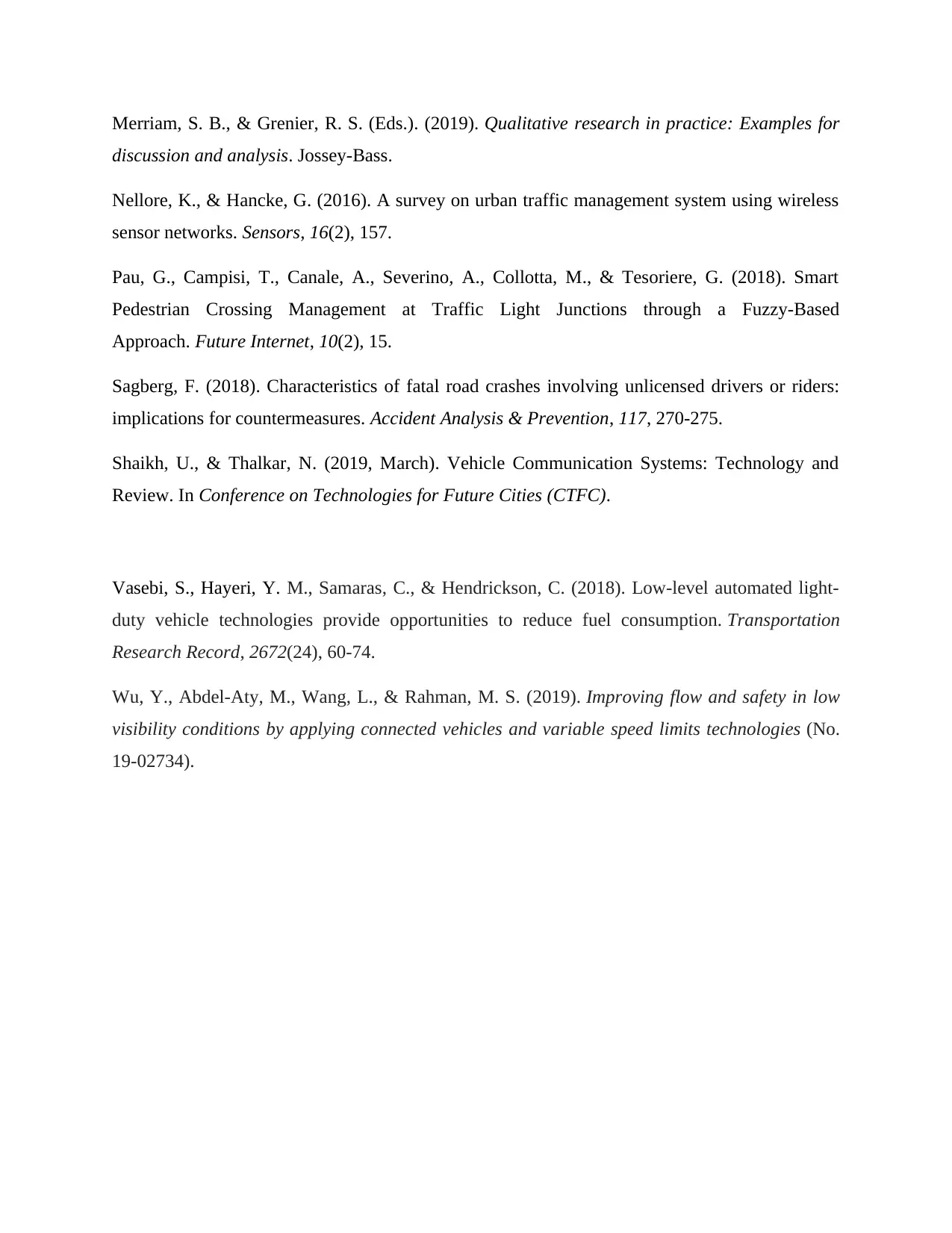
Merriam, S. B., & Grenier, R. S. (Eds.). (2019). Qualitative research in practice: Examples for
discussion and analysis. Jossey-Bass.
Nellore, K., & Hancke, G. (2016). A survey on urban traffic management system using wireless
sensor networks. Sensors, 16(2), 157.
Pau, G., Campisi, T., Canale, A., Severino, A., Collotta, M., & Tesoriere, G. (2018). Smart
Pedestrian Crossing Management at Traffic Light Junctions through a Fuzzy-Based
Approach. Future Internet, 10(2), 15.
Sagberg, F. (2018). Characteristics of fatal road crashes involving unlicensed drivers or riders:
implications for countermeasures. Accident Analysis & Prevention, 117, 270-275.
Shaikh, U., & Thalkar, N. (2019, March). Vehicle Communication Systems: Technology and
Review. In Conference on Technologies for Future Cities (CTFC).
Vasebi, S., Hayeri, Y. M., Samaras, C., & Hendrickson, C. (2018). Low-level automated light-
duty vehicle technologies provide opportunities to reduce fuel consumption. Transportation
Research Record, 2672(24), 60-74.
Wu, Y., Abdel-Aty, M., Wang, L., & Rahman, M. S. (2019). Improving flow and safety in low
visibility conditions by applying connected vehicles and variable speed limits technologies (No.
19-02734).
discussion and analysis. Jossey-Bass.
Nellore, K., & Hancke, G. (2016). A survey on urban traffic management system using wireless
sensor networks. Sensors, 16(2), 157.
Pau, G., Campisi, T., Canale, A., Severino, A., Collotta, M., & Tesoriere, G. (2018). Smart
Pedestrian Crossing Management at Traffic Light Junctions through a Fuzzy-Based
Approach. Future Internet, 10(2), 15.
Sagberg, F. (2018). Characteristics of fatal road crashes involving unlicensed drivers or riders:
implications for countermeasures. Accident Analysis & Prevention, 117, 270-275.
Shaikh, U., & Thalkar, N. (2019, March). Vehicle Communication Systems: Technology and
Review. In Conference on Technologies for Future Cities (CTFC).
Vasebi, S., Hayeri, Y. M., Samaras, C., & Hendrickson, C. (2018). Low-level automated light-
duty vehicle technologies provide opportunities to reduce fuel consumption. Transportation
Research Record, 2672(24), 60-74.
Wu, Y., Abdel-Aty, M., Wang, L., & Rahman, M. S. (2019). Improving flow and safety in low
visibility conditions by applying connected vehicles and variable speed limits technologies (No.
19-02734).
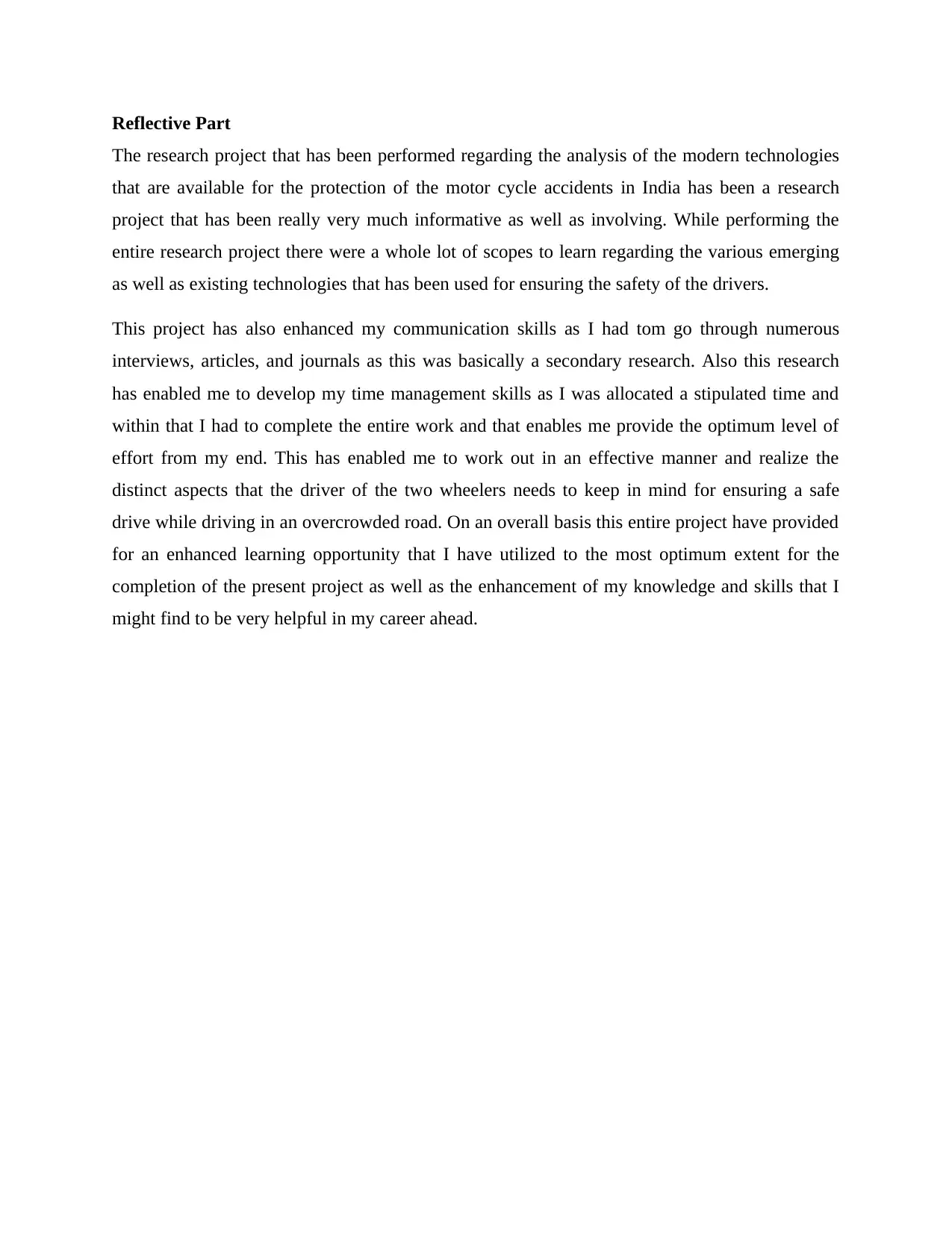
Reflective Part
The research project that has been performed regarding the analysis of the modern technologies
that are available for the protection of the motor cycle accidents in India has been a research
project that has been really very much informative as well as involving. While performing the
entire research project there were a whole lot of scopes to learn regarding the various emerging
as well as existing technologies that has been used for ensuring the safety of the drivers.
This project has also enhanced my communication skills as I had tom go through numerous
interviews, articles, and journals as this was basically a secondary research. Also this research
has enabled me to develop my time management skills as I was allocated a stipulated time and
within that I had to complete the entire work and that enables me provide the optimum level of
effort from my end. This has enabled me to work out in an effective manner and realize the
distinct aspects that the driver of the two wheelers needs to keep in mind for ensuring a safe
drive while driving in an overcrowded road. On an overall basis this entire project have provided
for an enhanced learning opportunity that I have utilized to the most optimum extent for the
completion of the present project as well as the enhancement of my knowledge and skills that I
might find to be very helpful in my career ahead.
The research project that has been performed regarding the analysis of the modern technologies
that are available for the protection of the motor cycle accidents in India has been a research
project that has been really very much informative as well as involving. While performing the
entire research project there were a whole lot of scopes to learn regarding the various emerging
as well as existing technologies that has been used for ensuring the safety of the drivers.
This project has also enhanced my communication skills as I had tom go through numerous
interviews, articles, and journals as this was basically a secondary research. Also this research
has enabled me to develop my time management skills as I was allocated a stipulated time and
within that I had to complete the entire work and that enables me provide the optimum level of
effort from my end. This has enabled me to work out in an effective manner and realize the
distinct aspects that the driver of the two wheelers needs to keep in mind for ensuring a safe
drive while driving in an overcrowded road. On an overall basis this entire project have provided
for an enhanced learning opportunity that I have utilized to the most optimum extent for the
completion of the present project as well as the enhancement of my knowledge and skills that I
might find to be very helpful in my career ahead.
⊘ This is a preview!⊘
Do you want full access?
Subscribe today to unlock all pages.

Trusted by 1+ million students worldwide
1 out of 12
Related Documents
Your All-in-One AI-Powered Toolkit for Academic Success.
+13062052269
info@desklib.com
Available 24*7 on WhatsApp / Email
![[object Object]](/_next/static/media/star-bottom.7253800d.svg)
Unlock your academic potential
Copyright © 2020–2025 A2Z Services. All Rights Reserved. Developed and managed by ZUCOL.




